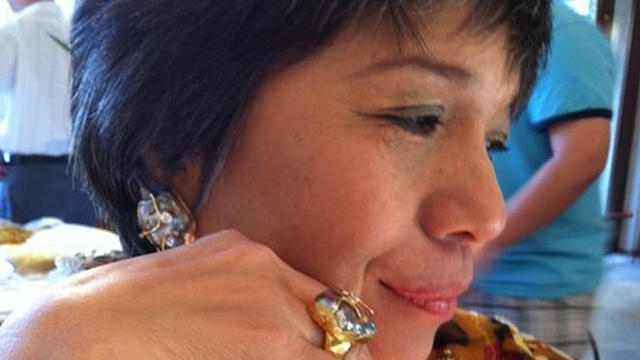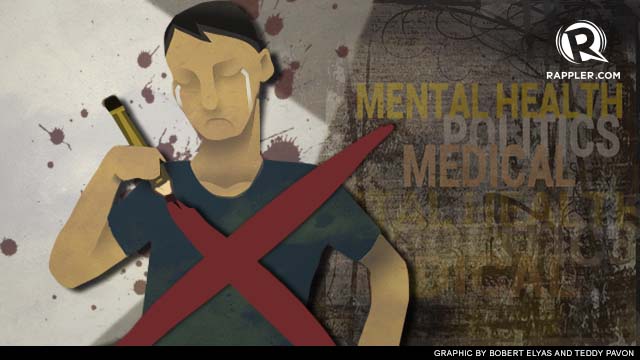SUMMARY
This is AI generated summarization, which may have errors. For context, always refer to the full article.
 Since Kristel Tejada’s suicide, media outlets in the Philippines have run articles, interviewed experts and shared research on depression and suicide. In Rappler.com alone, we have some of the best, including #TalkThursday’s interview with Cathy Babao, a grief educator and counselor.
Since Kristel Tejada’s suicide, media outlets in the Philippines have run articles, interviewed experts and shared research on depression and suicide. In Rappler.com alone, we have some of the best, including #TalkThursday’s interview with Cathy Babao, a grief educator and counselor.
Thus, I hope you don’t mind if I don’t go over similar territory (I mean, why reinvent the wheel, right?) but discuss certain political, medical and psychiatric factors involved in suicide, and make one final observation regarding our reaction to Kristel Tejada’s suicide.
Let us start with the Philippines: I agree with everything in CHED Chairperson Patricia B. Licuanan’s statement on the death of UP student Kristel Tejada, except the following: “…using Kristel’s apparent suicide to serve a political platform, no matter how valid, is unconscionable.”
My feeling is that, contrary to Dr Licuanan’s judgment as “unconscionable,” it makes perfect sense to use Kristel for reforms that certain groups are aiming for. I am talking pragmatics here, believing these groups, like us, feel strongly about what the country needs (even if we may not agree with their choices).
Every cause needs a poster child that can evoke passion in a way that the nameless, who may have suffered as much or even more, cannot. To share a quote attributed to Stalin: “A Single Death is a Tragedy; a Million Deaths is a Statistic.”
If Kristel’s death leads to better support systems and more effective counseling services for the depressed and confused, if it encourages a review of UP’s funding policies, if it shames politicians disguised as statesmen to give more of their pork barrel to education and facilitates the founding of organizations that can help UP alumni, for example, fund and support the current students enrolled at UP, then why not?
Here, at least, is one time when the Law of Unintended Consequences has worked out to be partly beneficial, even if born from tragedy.

Political
Dewie Chang Elma wrote on my Facebook wall: “Btw, here in Singapore, suicide attempt is criminalized. So you better make it work the first time. Parang disturbing the peace of society. But recently, they’re debating whether it’s humane after all. Help is needed, not punishment.”
Actually, this attitude (and response) did not start with Singapore.
In Georges Minois’ ”History of Suicide: Voluntary death in Western Culture (1999),” the French scholar shows how attitudes toward suicide have changed from the classical period into the modern era.
There have been times suicide has been looked upon positively. In ancient Rome, for example, there was the cult of ”the noble suicide,” embodied by Brutus, Antony and Cleopatra. And yet even then suicide was outlawed for slaves and foot soldiers ”because a slave belongs to the owner and he doesn’t own his life.”
Generally, however, nation states and the Roman Catholic Church view suicide negatively. Minois believes “suicide is deeply threatening to most governments…partly because it is an assertion of individual freedom against the power of the state; It is an affront to all political and religious systems.”
He continues: ”Anyone who chooses death and its unknowns displays a total lack of confidence in the theories, ideologies, beliefs, plans and promises of all leaders.” As a consequence, ”Whatever its nature, power seeks to prevent and conceal suicide.”
I agree that government, churches, schools and other institutions should do all they can to prevent suicides, especially those attempted when one is impulsive. But that doesn’t mean that part of the subtext of wanting to do everything to prevent suicide is not due to the implication that not being able to do so is, as Minois says, an affront to all political and religious systems.”
Something to think about, and think about deeply, right?
Medical/psychiatric
Again from Facebook, in preparation for the suicide episode on #AskMargie for March 30, I asked what questions people had about suicide.
Geruel de Ramos asked, “Is suicide a form of insanity?
To which Alfie Mella answers: “(I think someone who committed suicide) had a psychological imbalance or even mental disorder, in the premise that, a mentally healthy person would have had a functional coping mechanism against stress and other problems, enough for the person to surpass the struggle, using psychological strength…the fact that the person eventually succumbed to the stress and problem and ultimately killed himself is proof that he did not have a healthy psychological setup.”
Many have hypothesized that Kristel was depressed and she well could have been. Research is replete with the close connection between suicide and psychopathology.
I agree with Dr Kay Redfield Jamison, professor of psychiatry at the Johns Hopkins University School of Medicine and author of “Night Falls Fast: Understanding Suicide (1999).”
He says, ”Suicide, which is both a stereotypic yet highly individualized act, is a common endpoint for many patients with severe psychiatric illness…psychopathology is almost always there, and its deadliness is fierce. Love, success, and friendship are not always enough to counter the pain and destructiveness of severe mental illness.”
I also agree with Dr Arthur Kleinman, professor of psychiatry and medical anthropology at the Harvard Medical School, when he says we should be careful about quickly labeling a suicide completer (one who dies by his own hand, as opposed to one who merely attempts to, and survives) as depressed.
Beyond classifications
It is so easy to label a person as depressed and conclude that if he only had the right antidepressants it wouldn’t have happened. Dr Kleinman and – ahem – Dr Holmes both strongly believe that to look at suicide this simplistically misses the whole point.
It makes machines of people, dividing them into two major groups. The first group – the “templates,” the ideal designed on the drawing board, the goal aspired to, and which, happily some have achieved simply by having the right chemical balance to begin with.
The second group is like cars that have something wrong with them. None of them have the correct chemical balance. But this second group of people (who deviate slightly from the template) can be subdivided into two smaller groups, depending on which mechanic (psychiatrist) one goes to and what tools (mainly but not limited to, medication) he has.
The older models are the worst off. Despite research and treatment trials and new medications – SSRIs, now SSNIs, anti psychotics, etc – nothing seems to really help. The more fortunate sub-group can be considered the latest models, perhaps: new models who have found the right meds to keep them stable (and free from suicidal thoughts).
The latter group includes those who get prescribed the right combination of medications (mood stabilizers, anti-depressants, anti-psychotics, anti-convulsives) and live reasonably successful lives, despite the expense and side effects taking psychotropic meds usually entail.
Still they are considered a lucky bunch, even if their good luck seems a mere function of obeying doctors’ orders, rather than of a triumph of the human spirit over adversity – that black hole of despair which sticks to you like super glue you can’t get away from.
The unlucky bunch are those whose chemical imbalance stays imbalanced, no matter how hard the doctor tries to titrate their meds. But, to put it this simplistically, to use Dr Kleinman’s words, “strips suffering of its moral and emotional importance.”
And though I strongly believe in medication, I just as strongly feel medication alone is not enough. For a psychiatrist to think and push only medication is similar to a sex therapist focusing on calisthenics for better sex. There is no doubt it might help and help a lot – but like icing on a cake, without the flour and eggs, the icing will cover a non cake.
Without listening to, and resonating with, the person taking the meds, suicide might not be avoided.
There are, of course, cultural and philosophical (moral) aspects involved in the act of suicide and a population’s response to it, but I will wait to see if you’re interested in what a clinical psychologist has to say about these two issues, okay? – Rappler.com
Add a comment
How does this make you feel?
There are no comments yet. Add your comment to start the conversation.